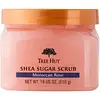What's inside
What's inside
 Key Ingredients
Key Ingredients

 Benefits
Benefits

 Concerns
Concerns

 Ingredients Side-by-side
Ingredients Side-by-side

Sucrose
HumectantGlycerin
HumectantPolysorbate 20
EmulsifyingSilica
AbrasiveParfum
MaskingOenothera Biennis Oil
EmollientPersea Gratissima Oil
Skin ConditioningRosa Canina Fruit Oil
EmollientArgania Spinosa Kernel Oil
EmollientPrunus Amygdalus Dulcis Oil
Skin ConditioningButyrospermum Parkii Butter
Skin ConditioningCarthamus Tinctorius Seed Oil
MaskingCitrus Aurantium Dulcis Oil
MaskingMacadamia Ternifolia Seed Oil
EmollientRetinyl Palmitate
Skin ConditioningAscorbic Acid
AntioxidantPhenoxyethanol
PreservativeCaprylyl Glycol
EmollientSorbic Acid
PreservativeBlue 1 Lake
Cosmetic ColorantCI 14700
Cosmetic ColorantSucrose, Glycerin, Polysorbate 20, Silica, Parfum, Oenothera Biennis Oil, Persea Gratissima Oil, Rosa Canina Fruit Oil, Argania Spinosa Kernel Oil, Prunus Amygdalus Dulcis Oil, Butyrospermum Parkii Butter, Carthamus Tinctorius Seed Oil, Citrus Aurantium Dulcis Oil, Macadamia Ternifolia Seed Oil, Retinyl Palmitate, Ascorbic Acid, Phenoxyethanol, Caprylyl Glycol, Sorbic Acid, Blue 1 Lake, CI 14700
Water
Skin ConditioningGlycerin
HumectantSodium Lauroyl Isethionate
CleansingStearic Acid
CleansingHydrated Silica
AbrasiveSodium Stearate
CleansingCocamidopropyl Betaine
CleansingLauric Acid
CleansingSodium Oleate
CleansingParfum
MaskingColloidal Oatmeal
AbsorbentCalendula Officinalis Flower Extract
MaskingSodium Isethionate
CleansingCetearyl Alcohol
EmollientSodium Chloride
MaskingSynthetic Wax
AbrasiveSodium Laurate
CleansingSodium Benzoate
MaskingHydroxyacetophenone
AntioxidantTetrasodium EDTA
Tetrasodium Etidronate
Emulsion StabilisingCaprylic/Capric Triglyceride
MaskingTitanium Dioxide
Cosmetic ColorantCI 42090
Cosmetic ColorantCI 19140
Cosmetic ColorantCI 17200
Cosmetic ColorantCI 77492
Cosmetic ColorantCI 77491
Cosmetic ColorantCI 77499
Cosmetic ColorantWater, Glycerin, Sodium Lauroyl Isethionate, Stearic Acid, Hydrated Silica, Sodium Stearate, Cocamidopropyl Betaine, Lauric Acid, Sodium Oleate, Parfum, Colloidal Oatmeal, Calendula Officinalis Flower Extract, Sodium Isethionate, Cetearyl Alcohol, Sodium Chloride, Synthetic Wax, Sodium Laurate, Sodium Benzoate, Hydroxyacetophenone, Tetrasodium EDTA, Tetrasodium Etidronate, Caprylic/Capric Triglyceride, Titanium Dioxide, CI 42090, CI 19140, CI 17200, CI 77492, CI 77491, CI 77499
 Reviews
Reviews

Ingredients Explained
These ingredients are found in both products.
Ingredients higher up in an ingredient list are typically present in a larger amount.
Glycerin is already naturally found in your skin. It helps moisturize and protect your skin.
A study from 2016 found glycerin to be more effective as a humectant than AHAs and hyaluronic acid.
As a humectant, it helps the skin stay hydrated by pulling moisture to your skin. The low molecular weight of glycerin allows it to pull moisture into the deeper layers of your skin.
Hydrated skin improves your skin barrier; Your skin barrier helps protect against irritants and bacteria.
Glycerin has also been found to have antimicrobial and antiviral properties. Due to these properties, glycerin is often used in wound and burn treatments.
In cosmetics, glycerin is usually derived from plants such as soybean or palm. However, it can also be sourced from animals, such as tallow or animal fat.
This ingredient is organic, colorless, odorless, and non-toxic.
Glycerin is the name for this ingredient in American English. British English uses Glycerol/Glycerine.
Learn more about GlycerinParfum is a catch-all term for an ingredient or more that is used to give a scent to products.
Also called "fragrance", this ingredient can be a blend of hundreds of chemicals or plant oils. This means every product with "fragrance" or "parfum" in the ingredients list is a different mixture.
For instance, Habanolide is a proprietary trade name for a specific aroma chemical. When used as a fragrance ingredient in cosmetics, most aroma chemicals fall under the broad labeling category of “FRAGRANCE” or “PARFUM” according to EU and US regulations.
The term 'parfum' or 'fragrance' is not regulated in many countries. In many cases, it is up to the brand to define this term.
For instance, many brands choose to label themselves as "fragrance-free" because they are not using synthetic fragrances. However, their products may still contain ingredients such as essential oils that are considered a fragrance by INCI standards.
One example is Calendula flower extract. Calendula is an essential oil that still imparts a scent or 'fragrance'.
Depending on the blend, the ingredients in the mixture can cause allergies and sensitivities on the skin. Some ingredients that are known EU allergens include linalool and citronellol.
Parfum can also be used to mask or cover an unpleasant scent.
The bottom line is: not all fragrances/parfum/ingredients are created equally. If you are worried about fragrances, we recommend taking a closer look at an ingredient. And of course, we always recommend speaking with a professional.
Learn more about Parfum